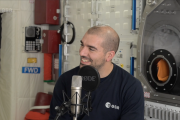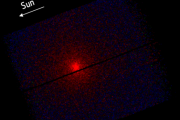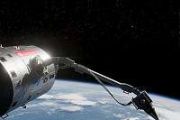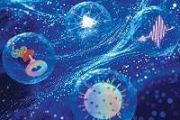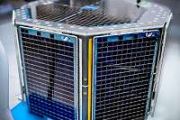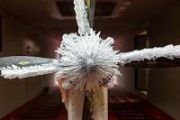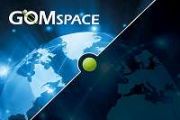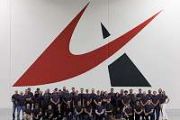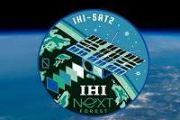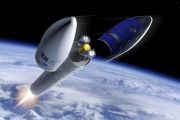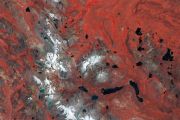
Copernical Team
Johns Hopkins APL assembles first global map of lunar hydrogen
 Using data collected over two decades ago, scientists from the Johns Hopkins Applied Physics Laboratory (APL) in Laurel, Maryland, have compiled the first complete map of hydrogen abundances on the Moon's surface. The map identifies two types of lunar materials containing enhanced hydrogen and corroborates previous ideas about lunar hydrogen and water, including findings that water likely played
Using data collected over two decades ago, scientists from the Johns Hopkins Applied Physics Laboratory (APL) in Laurel, Maryland, have compiled the first complete map of hydrogen abundances on the Moon's surface. The map identifies two types of lunar materials containing enhanced hydrogen and corroborates previous ideas about lunar hydrogen and water, including findings that water likely played Laser marking on Mars
 If your name begins with "L" you will like this post about the first letter to be laser engraved on Mars. Every once in a while, we see cartoons in which a Mars rover is driven in a pattern to make letters in the sand with its wheel tracks. The letters spell out a silly phrase, and the cartoon usually has aliens on the side, laughing or puzzling over the meaning. The use of lasers on board Mars
If your name begins with "L" you will like this post about the first letter to be laser engraved on Mars. Every once in a while, we see cartoons in which a Mars rover is driven in a pattern to make letters in the sand with its wheel tracks. The letters spell out a silly phrase, and the cartoon usually has aliens on the side, laughing or puzzling over the meaning. The use of lasers on board Mars Why Jupiter doesn't have rings like Saturn
 Because it's bigger, Jupiter ought to have larger, more spectacular rings than Saturn has. But new UC Riverside research shows Jupiter's massive moons prevent that vision from lighting up the night sky.
"It's long bothered me why Jupiter doesn't have even more amazing rings that would put Saturn's to shame," said UCR astrophysicist Stephen Kane, who led the research.
"If Jupiter did
Because it's bigger, Jupiter ought to have larger, more spectacular rings than Saturn has. But new UC Riverside research shows Jupiter's massive moons prevent that vision from lighting up the night sky.
"It's long bothered me why Jupiter doesn't have even more amazing rings that would put Saturn's to shame," said UCR astrophysicist Stephen Kane, who led the research.
"If Jupiter did NASA selects Draper to for Lunar Far Side mission
 NASA has awarded Draper of Cambridge, Massachusetts a contract to deliver Artemis science investigations to the Moon in 2025. The commercial delivery is part of NASA's Commercial Lunar Payload Services (CLPS) initiative under Artemis.
Draper will receive $73 million for the contract, and is responsible for end-to-end delivery services, including payload integration, delivery from Earth to
NASA has awarded Draper of Cambridge, Massachusetts a contract to deliver Artemis science investigations to the Moon in 2025. The commercial delivery is part of NASA's Commercial Lunar Payload Services (CLPS) initiative under Artemis.
Draper will receive $73 million for the contract, and is responsible for end-to-end delivery services, including payload integration, delivery from Earth to New method increases lunar mapping accuracy to unprecedented levels
 TOPOGRAPHY: The surface of the moon and rocky planets, Mars in particular, are of huge interest to anyone trying to explore our solar system. The surface must be known in as much detail as possible, for missions to land safely, or for any robotic vessel to drive across the surface. But until now, the methods to analyze images from e.g. orbiting spacecraft have entailed a huge work load and immen
TOPOGRAPHY: The surface of the moon and rocky planets, Mars in particular, are of huge interest to anyone trying to explore our solar system. The surface must be known in as much detail as possible, for missions to land safely, or for any robotic vessel to drive across the surface. But until now, the methods to analyze images from e.g. orbiting spacecraft have entailed a huge work load and immen Russian, European astronauts make rare joint spacewalk at ISS
 A Russian cosmonaut and European Space Agency engineer made a several-hour spacewalk at the International Space Station on Thursday to work on a robotic laboratory arm.
The pair began the spacewalk around 10 a.m. EDT and it was scheduled to last about six hours.
The objective of the mission is to continue outfitting the European robotic arm on the ISS Nauka laboratory.
Com
A Russian cosmonaut and European Space Agency engineer made a several-hour spacewalk at the International Space Station on Thursday to work on a robotic laboratory arm.
The pair began the spacewalk around 10 a.m. EDT and it was scheduled to last about six hours.
The objective of the mission is to continue outfitting the European robotic arm on the ISS Nauka laboratory.
Com Northrop Grumman and NASA test SLS booster
 Northrop Grumman and NASA have conducted a full-scale static fire of NASA's Space Launch System (SLS) rocket motor, known as Flight Support Booster-2. The five-segment solid rocket booster is the world's largest solid rocket motor and will provide more than 75 percent of the SLS rocket's initial thrust during launch.
Over 300 measurement channels assessed the 154-foot-long solid rocket boo
Northrop Grumman and NASA have conducted a full-scale static fire of NASA's Space Launch System (SLS) rocket motor, known as Flight Support Booster-2. The five-segment solid rocket booster is the world's largest solid rocket motor and will provide more than 75 percent of the SLS rocket's initial thrust during launch.
Over 300 measurement channels assessed the 154-foot-long solid rocket boo SpaceX delays 32nd launch of year, putting off attempt at record for one more day
 SpaceX will delay Thursday's Starlink launch, an attempt by the company to beat its record of 31 launches in 2021 with a 32nd launch this year, until Friday because of fog.
The countdown to launch was aborted seconds ahead of the Falcon 9 rocket's planned launch of 46 Starlink satellites to low-Earth orbit from the from the Vandenberg Space Force Base in California.
The lift off
SpaceX will delay Thursday's Starlink launch, an attempt by the company to beat its record of 31 launches in 2021 with a 32nd launch this year, until Friday because of fog.
The countdown to launch was aborted seconds ahead of the Falcon 9 rocket's planned launch of 46 Starlink satellites to low-Earth orbit from the from the Vandenberg Space Force Base in California.
The lift off Georgia spaceport land deal is off, site owner says

You can see where the Webb Telescope took a direct hit from a micrometeorite on one of its mirrors

The world is still reeling from the release of the James Webb Space Telescope's (JWST) first images. These provided a comprehensive overview of the kind of science operations that Webb will conduct over its 20-year mission. They included the most sensitive and detailed look at some iconic astronomical objects, spectra from an exoplanet atmosphere, and a deep field view of some of the most distant galaxies in the universe. Since their release, we've also been treated to glimpses of objects in the solar system captured by Webb's infrared instruments.
Meanwhile, the JWST collaboration released a full report titled titled "Characterization of JWST science performance from commissioning," in which they examined everything Webb has accomplished so far and what they anticipate throughout the mission.






